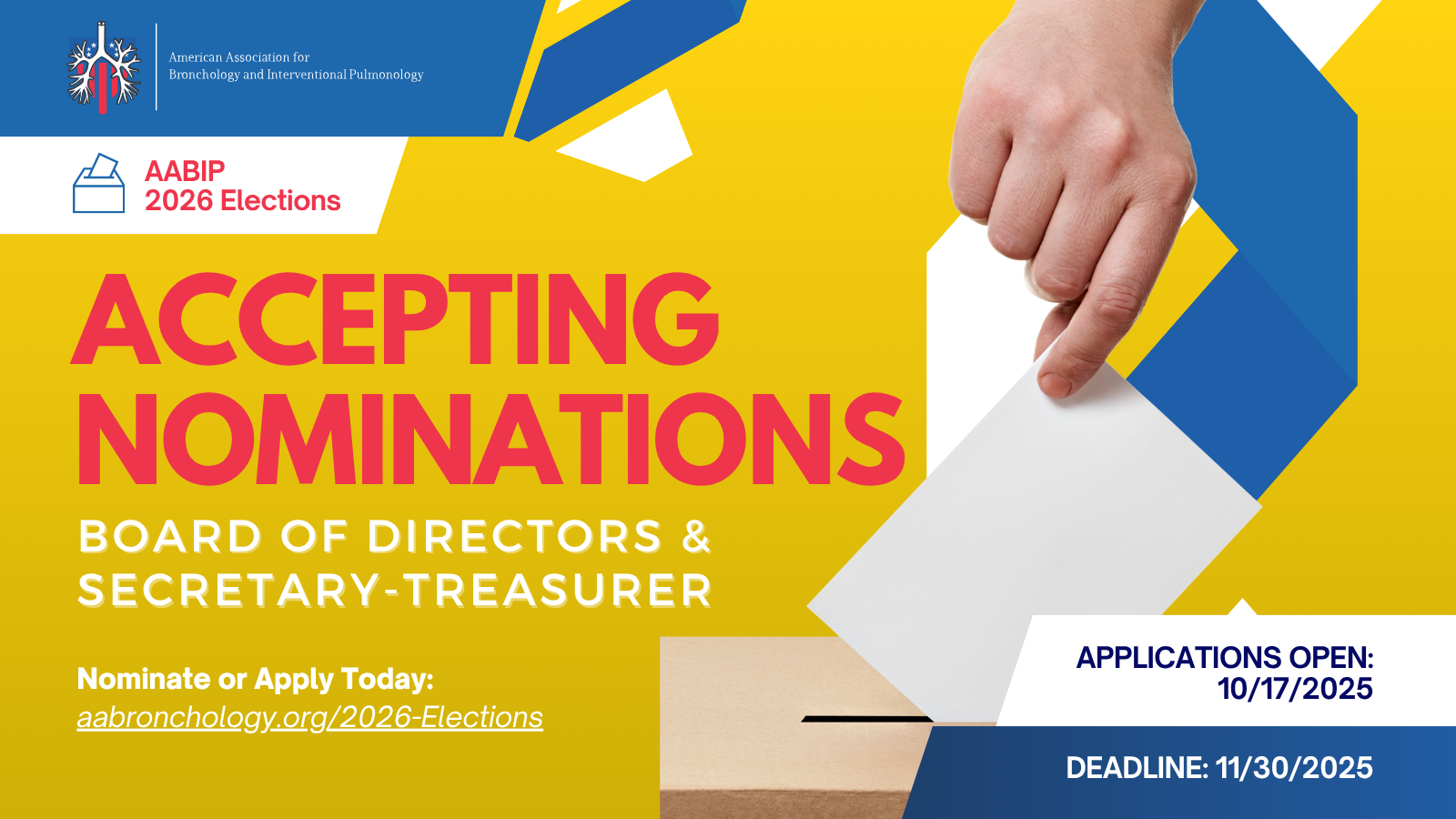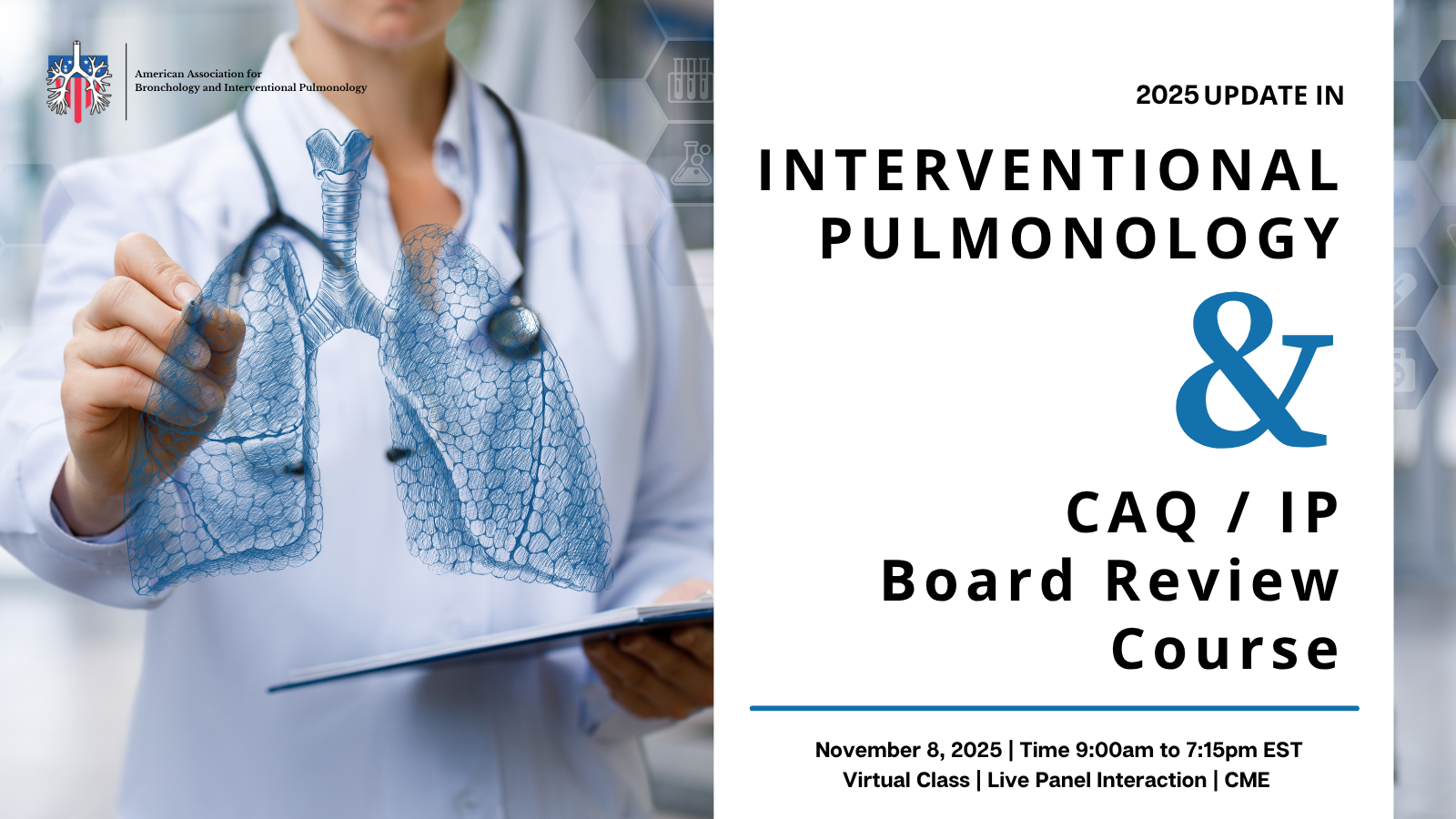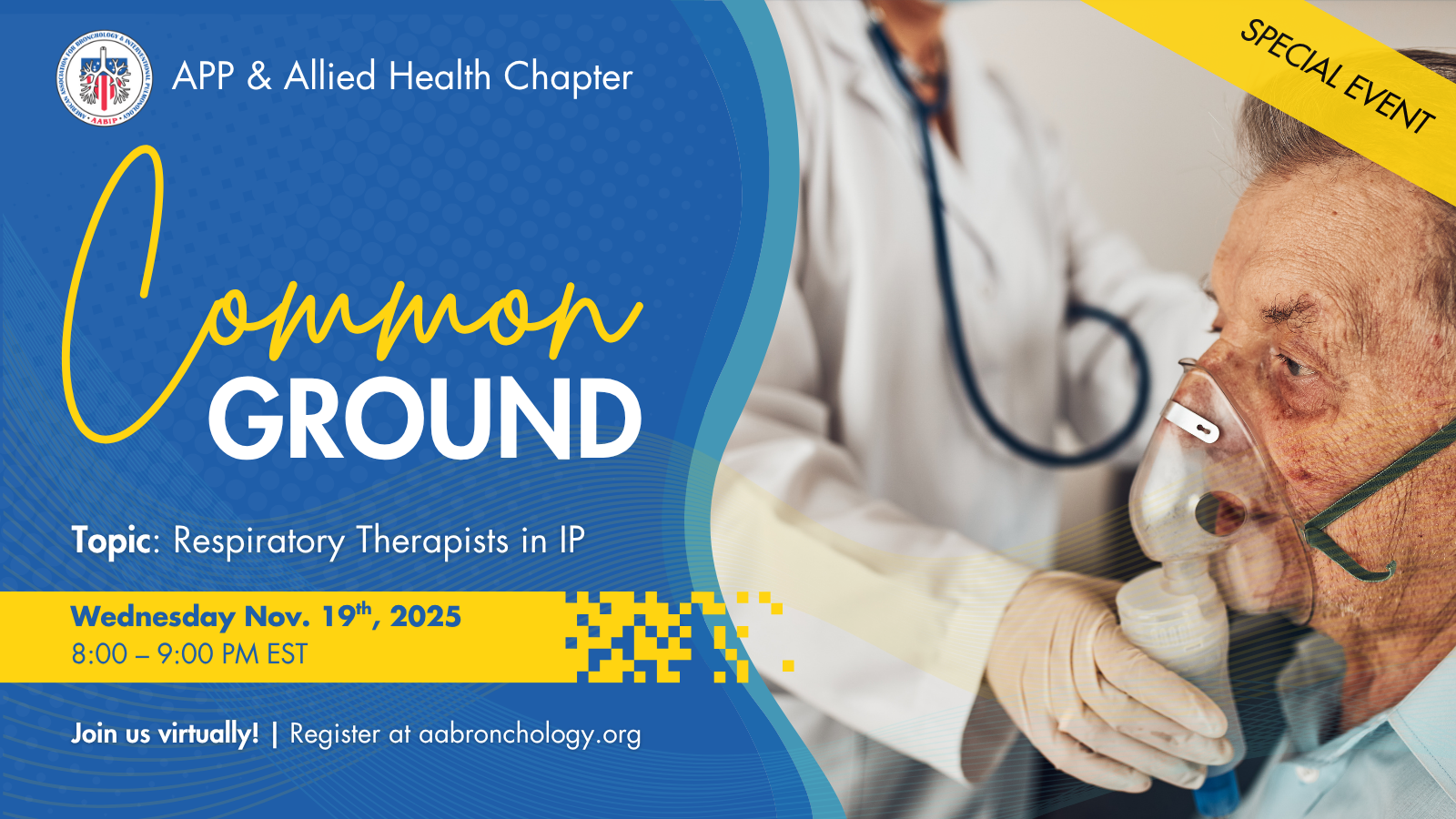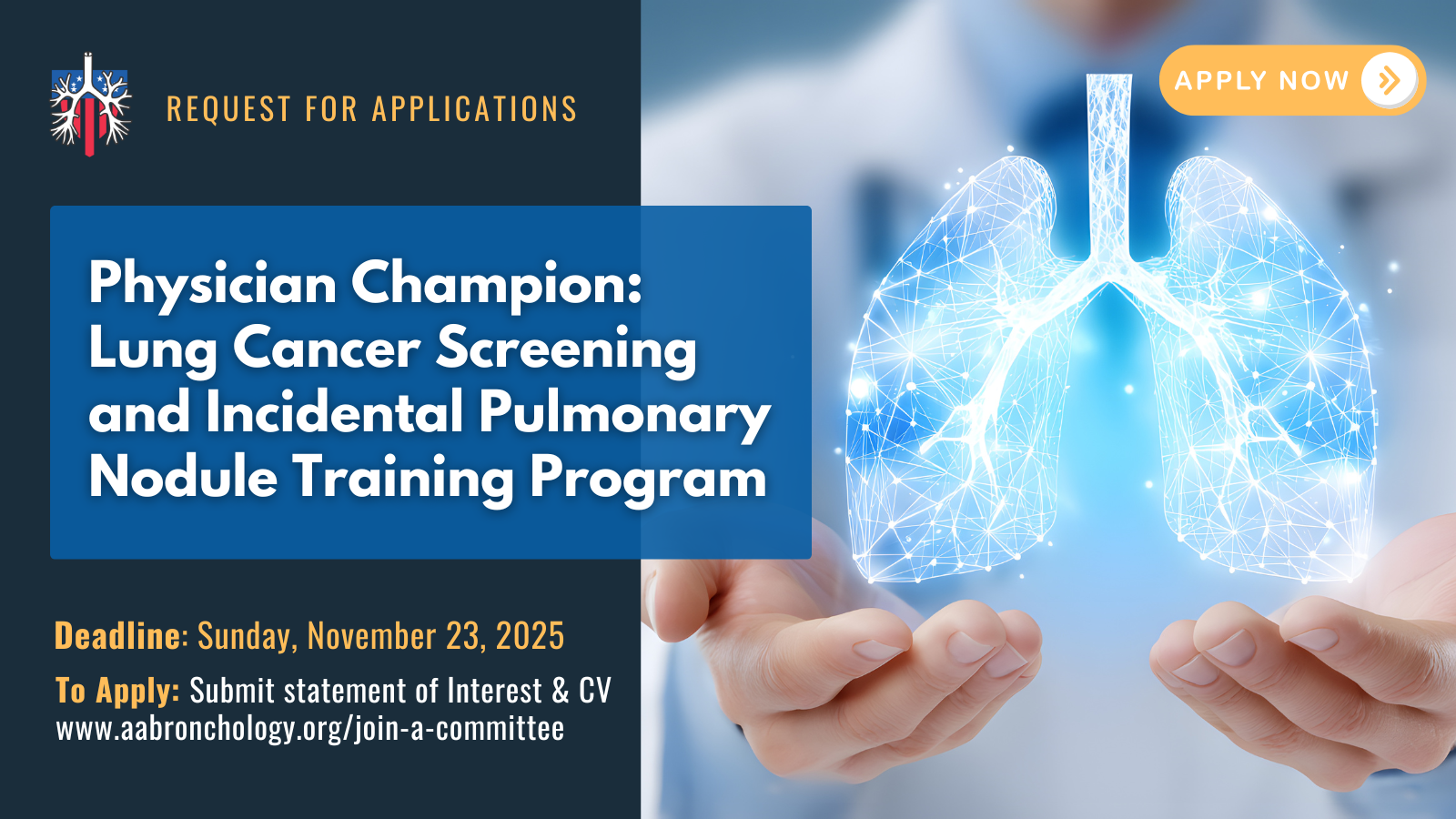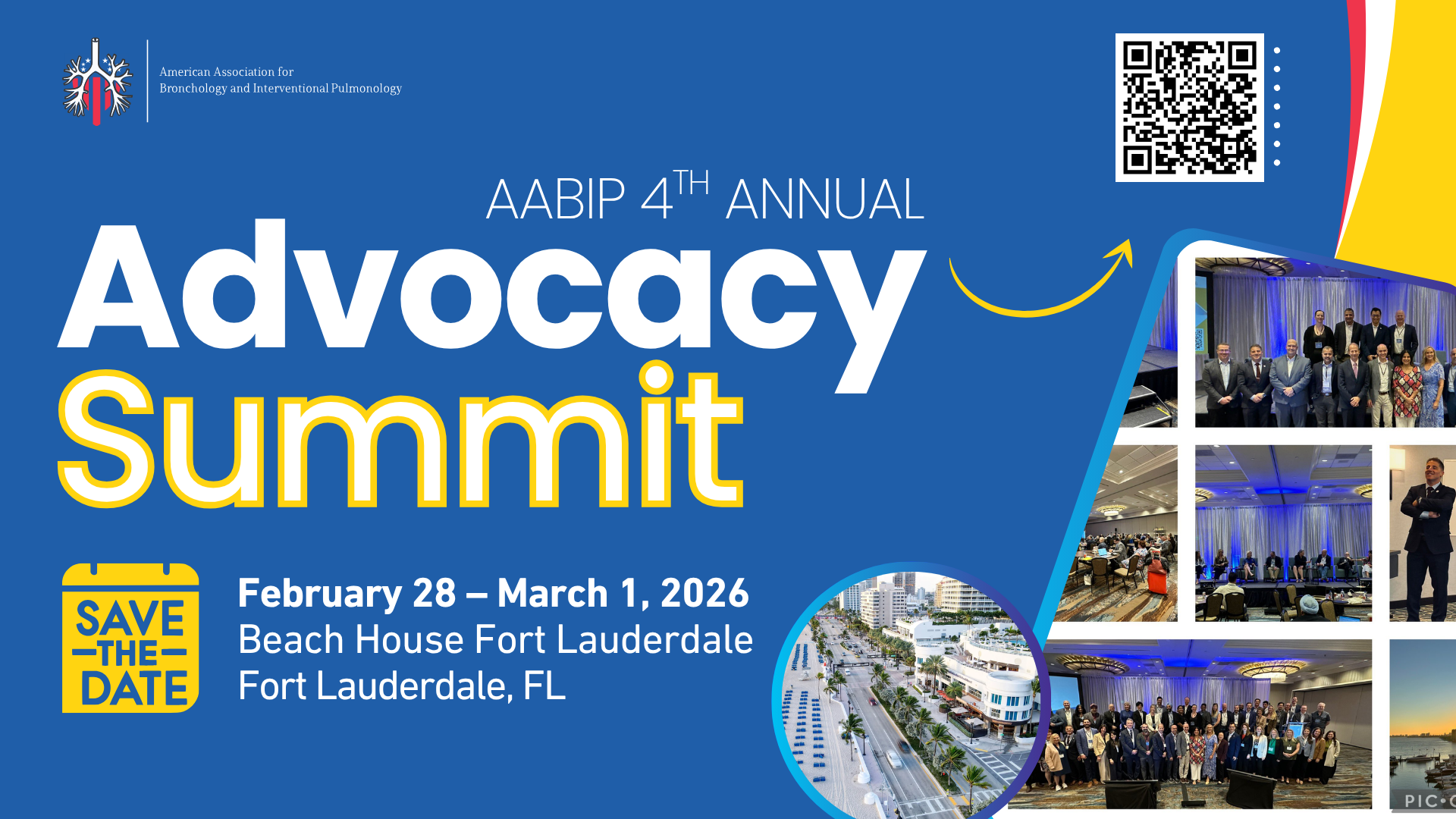AABIP Advocacy Statement
Back
Position Statement on the Use of Modifier 52 with CPT Codes for Bronchoscopy
Issued by the American Association of Bronchology and Interventional Pulmonology (AABIP)
Background
Accurate CPT coding is essential for appropriate reimbursement and documentation of bronchoscopic procedures. Modifier 52 (Reduced Services) is intended to reflect a partial reduction in service at the provider’s discretion, but its application to bronchoscopy—particularly when performed via a tracheostomy or endotracheal tube (ETT)—has caused confusion. An August 2021 CPT Assistant article suggested applying Modifier 52 in cases where bronchoscopy is performed via a tracheostomy or ETT, citing perceived reductions in procedural complexity from bypassing the upper airway. However, this interpretation is not supported by CMS or any professional respiratory societies and goes against best practices in bronchoscopy. This position statement seeks to clarify the appropriate use of Modifier 52 and provide recommendations aligned with the clinical evolution of bronchoscopy practice using advanced technologies and in increasingly complex patients.
Clinical Evolution of Bronchoscopy
In recent decades, bronchoscopy has advanced considerably with the adoption of techniques that changed the way we diagnose and treat a multitude of lung disorders such as lung cancer and COPD. These include endobronchial ultrasound (EBUS), advanced navigation bronchoscopy platforms including robotic-assisted bronchoscopy, and therapeutic interventions such as bronchoscopic lung volume reduction. The vast majority of these procedures are routinely performed under general anesthesia with ETT, pre-existing indwelling tracheostomy tube or supraglottic airway access to enhance patient safety, and procedural precision (1-8).
Use of an artificial airway—whether an ETT or laryngeal mask—is often medically necessary and represents standard of care, not a reduction in service. In fact, such access is commonly required due to increasing procedural complexity and patient acuity. Furthermore, bronchoscopy is performed through an ETT or pre-existing tracheostomy tube because of patients’ comorbidities require the presence of an artificial airway but patients’ physiology remains a risk factor for complications such as bronchospasm, hypoxemia, bleeding, arrythmias or elevated intracranial pressures (9-11). When performed under general anesthesia, bronchoscopic procedures through an indwelling tracheostomy tube require exchanging an uncuffed to a cuffed tracheostomy or endotracheal tube to allow for optimal ventilation and oxygenation during the procedure; this maneuver, although often performed through an established tract, increases the complexity and potential risks of the intervention (21).
Key points:
- Urgent, emergent or elective bronchoscopies with BAL are performed in critically ill patients who have an indwelling ETT or tracheostomy tube. These patients often suffer from severe COPD, asthma, pulmonary hypertension, chronic or acute hypoxemia, intra-cranial processes that puts them at risk for complications (bronchospasm, hypoxemia, bleeding, elevated intracranial pressure) even in the presence of an artificial airway (12-15) Therefore, in many patients, it is neither feasible nor safe to attempt these procedures through the native upper airway in an ICU or operating room setting or where specific risks are expected.
- Many elective diagnostic and therapeutic bronchoscopic procedures require an artificial airway for adequate ventilation, oxygenation, airway protection from gastric content aspiration, properly managing potential procedure- related airway bleeding and for procedural precision (16-19). Changing an uncuffed to a cuffed tracheostomy tube prior or even after establishment of fistula tract, increases the complexity and risks of the procedure.
- As summarized herein, published evidence shows that performing bronchoscopy via an ETT, tracheostomy tube or other artificial airways ( e.g. LMA) is not a “reduction” in services — in fact, it often represents increased complexity due to patient’s physiology, comorbidities, ventilator management, need for optimal sedation and analgesia, and procedural logistics.
CMS and NCCI Policy Context
The 2025 CMS NCCI Medicare Policy Manual (20) reinforces our position:
- Section I-6 (Coding Based on Standards of Medical/Surgical Practice) emphasizes the importance of coding in line with current standards of medical/surgical practice.
- The manual also notes that airway access is necessary for general anesthesia and is not separately reportable, indicating that the presence of an ETT is considered part of the anesthesia and procedure setup, not a reduced service.
- Furthermore, under Section I-14 (Modifiers and Modifier Indicators), CMS stresses that modifiers should not be applied without clinical justification and specifically warns against misuse to circumvent edits or apply assumptions not consistent with clinical standards.
There is no CMS requirement to apply Modifier 52 to CPT 31624 or any other bronchoscopy codes when performed through an ETT, nor do current coding principles support the assumption that this represents a reduction in work.
AABIP Recommendations on the Use of Modifier 52
- Do not apply Modifier 52 routinely to bronchoscopy codes, as bronchoscopy procedures vary based on patient’s airway anatomy, pulmonary pathology, cardiovascular comorbidities, immunosuppressed state or other co-existing disorders that puts them at high risk for complications and do not indicate reduced service.
Remark: Patients might require artificial airway pre-bronchoscopy because of their underlying illness which puts them at high risk for bronchoscopy-related complications.
- Use Modifier 52 only when the procedure is substantially incomplete, such as when it is aborted before any meaningful intervention due to patient instability.
- Base coding on clinical intent. ETT use is a standard, often necessary component of modern bronchoscopy and does not warrant Modifier 52. Bronchoscopy in patients with severe comorbidities require an artificial airway or is performed in ill patients with pre-existing tracheostomy and the Modifier 52 should not be used in such cases.
- Do not apply Modifier 52 to bronchoscopies performed under general anesthesia through an indwelling tracheostomy or ETT as these procedures are by default complex and pose higher risks for complications.
Conclusion
The AABIP strongly advocates for the appropriate use of Modifier 52 for bronchoscopies performed via ETT or other artificial airways. Routine application of Modifier 52 misrepresents the service provided, imposes unnecessary administrative burdens, and undermines reimbursement for standard, often more complex care. We urge all stakeholders—clinicians, coders, and payers—to align documentation and billing practices with modern bronchoscopy standards using complex technologies in increasingly complex patients and reserve Modifier 52 for clearly reduced services.
By adhering to these principles, we can ensure patient safety, equitable reimbursement, accurate documentation, and continued advancements in the care of patients requiring bronchoscopy without unnecessary and clinically unjustified administrative obstacles.
References:
- Folch EE, Pritchett MA, Nead MA, et al; NAVIGATE Study Investigators. Electromagnetic navigation bronchoscopy for peripheral pulmonary lesions: one-year results of the prospective, multicenter NAVIGATE study. J Thorac Oncol. 2019;14(3):445-458. doi:10.1016/j.jtho.2018.11.013. PMID: 30476574.
- Chen AC, Pastis NJ Jr, Mahajan AK, et al. Robotic bronchoscopy for peripheral pulmonary lesions: a multicenter pilot and feasibility study (BENEFIT). Chest. 2021;159(2):845-852. doi:10.1016/j.chest.2020.08.2047. PMID: 32822675; PMCID: PMC7856527.
- Agrawal A, Hogarth DK, Murgu S. Robotic bronchoscopy for pulmonary lesions: a review of existing technologies and clinical data. J Thorac Dis. 2020;12(6):3279-3286. doi:10.21037/jtd.2020.03.35. PMID: 32642251; PMCID: PMC7330790.
- Chaddha U, Kovacs SP, Manley C, et al. Robot-assisted bronchoscopy for pulmonary lesion diagnosis: results from the initial multicenter experience. BMC Pulm Med. 2019;19(1):243. doi:10.1186/s12890-019-1010-8. PMID: 31829148; PMCID: PMC6907137.
- Yasufuku K, Pierre A, Darling G, et al. A prospective controlled trial of endobronchial ultrasound-guided transbronchial needle aspiration compared with mediastinoscopy for mediastinal lymph node staging of lung cancer. J Thorac Cardiovasc Surg. 2011;142(6):1393-1400.e1. doi:10.1016/j.jtcvs.2011.08.037. PMID: 21963329.
- Casal RF, Lazarus DR, Kuhl K, et al. Randomized trial of endobronchial ultrasound-guided transbronchial needle aspiration under general anesthesia versus moderate sedation. Am J Respir Crit Care Med. 2015;191(7):796-803. doi:10.1164/rccm.201409-1615OC. PMID: 25574801; PMCID: PMC4407485.
- Sciurba FC, Ernst A, Herth FJ, et al; VENT Study Research Group. A randomized study of endobronchial valves for advanced emphysema. N Engl J Med. 2010;363(13):1233-1244. doi:10.1056/NEJMoa0900928. PMID: 20860505.
- Criner GJ, Sue R, Wright S, et al; LIBERATE Study Group. A multicenter randomized controlled trial of Zephyr endobronchial valve treatment in heterogeneous emphysema (LIBERATE). Am J Respir Crit Care Med. 2018;198(9):1151-1164. doi:10.1164/rccm.201803-0590OC. PMID: 29787288.
- Dweik RA, Mehta AC, Meeker DP, Arroliga AC. Analysis of the safety of bronchoscopy after recent acute myocardial infarction. Chest. 1996;110(3):825-828. doi:10.1378/chest.110.3.825. PMID: 8797432.
- Wahidi MM, Rocha AT, Hollingsworth JW, et al. Contraindications and safety of transbronchial lung biopsy via flexible bronchoscopy: a survey of pulmonologists and review of the literature. Respiration. 2005;72(3):285-295. doi:10.1159/000085370. PMID: 15942298.
- Hattotuwa K, Gamble EA, O'Shaughnessy T, et al. Safety of bronchoscopy, biopsy, and BAL in research patients with COPD. Chest. 2002;122(6):1909-1912. doi:10.1378/chest.122.6.1909. PMID: 12475825.
- Pue CA, Pacht ER. Complications of fiberoptic bronchoscopy at a university hospital. Chest. 1995;107(2):430-432. doi:10.1378/chest.107.2.430. PMID: 7842773.
- Suratt PM, Smiddy JF, Gruber B. Deaths and complications associated with fiberoptic bronchoscopy. Chest. 1976;69(6):747-751. doi:10.1378/chest.69.6.747. PMID: 1277893.
- Peerless JR, Snow N, Likavec MJ, et al. The effect of fiberoptic bronchoscopy on cerebral hemodynamics in patients with severe head injury. Chest. 1995;108(4):962-965. doi:10.1378/chest.108.4.962. PMID: 7555169.
- Kreider ME, Lipson DA. Bronchoscopy for atelectasis in the ICU: a case report and review of the literature. Chest. 2003;124(1):344-350. doi:10.1378/chest.124.1.344. PMID: 12853543.
- Peikert T, Rana S, Edell ES. Safety, diagnostic yield, and therapeutic implications of flexible bronchoscopy in patients with febrile neutropenia and pulmonary infiltrates. Mayo Clin Proc. 2005;80(11):1414-1420. doi:10.4065/80.11.1414. PMID: 16295020.
- Zou M, Tang L, Zhao S, et al. Systematic review and meta-analysis of detecting galactomannan in bronchoalveolar lavage fluid for diagnosing invasive aspergillosis. PLoS One. 2012;7(8):e43347. doi:10.1371/journal.pone.0043347. PMID: 22905261; PMCID: PMC3419176.
- Lentini C, Granlund B. Anesthetic considerations for bronchoscopic procedures. In: StatPearls [Internet]. Treasure Island (FL): StatPearls Publishing; 2025. Updated 2023 May 22. Available from: https://www.ncbi.nlm.nih.gov/books/NBK572074/
- Sakr L, Dutau H. Massive hemoptysis: an update on the role of bronchoscopy in diagnosis and management. Respiration. 2010;80(1):38-58. doi:10.1159/000274492. PMID: 20090288.
- Centers for Medicare & Medicaid Services (CMS). Medicare National Correct Coding Initiative (NCCI) Policy Manual for Medicare Services. 2025 ed. https://www.cms.gov/medicare/coding-billing/national-correct-coding-initiative-ncci-edits/medicare-ncci-policy-manual. Accessed March 31, 2025.
- Ng J, Hamrang-Yousefi S, Hohman MH, et al. Tracheostomy Tube Change. [Updated 2024 Feb 14]. In: StatPearls [Internet]. Treasure Island (FL): StatPearls Publishing; 2025 Jan-. Available from: https://www.ncbi.nlm.nih.gov/books/NBK555919/
*Drafted by Drs. Laura Frye, George Cheng, Tom Gildea and Septimiu Murgu on behalf of the AABIP Advocacy Committee; reviewed, revised and approved by the AABIP Advocacy Committee on 6/5/2025 and by the AABIP Board of Directors on 5/21/2025.
|


